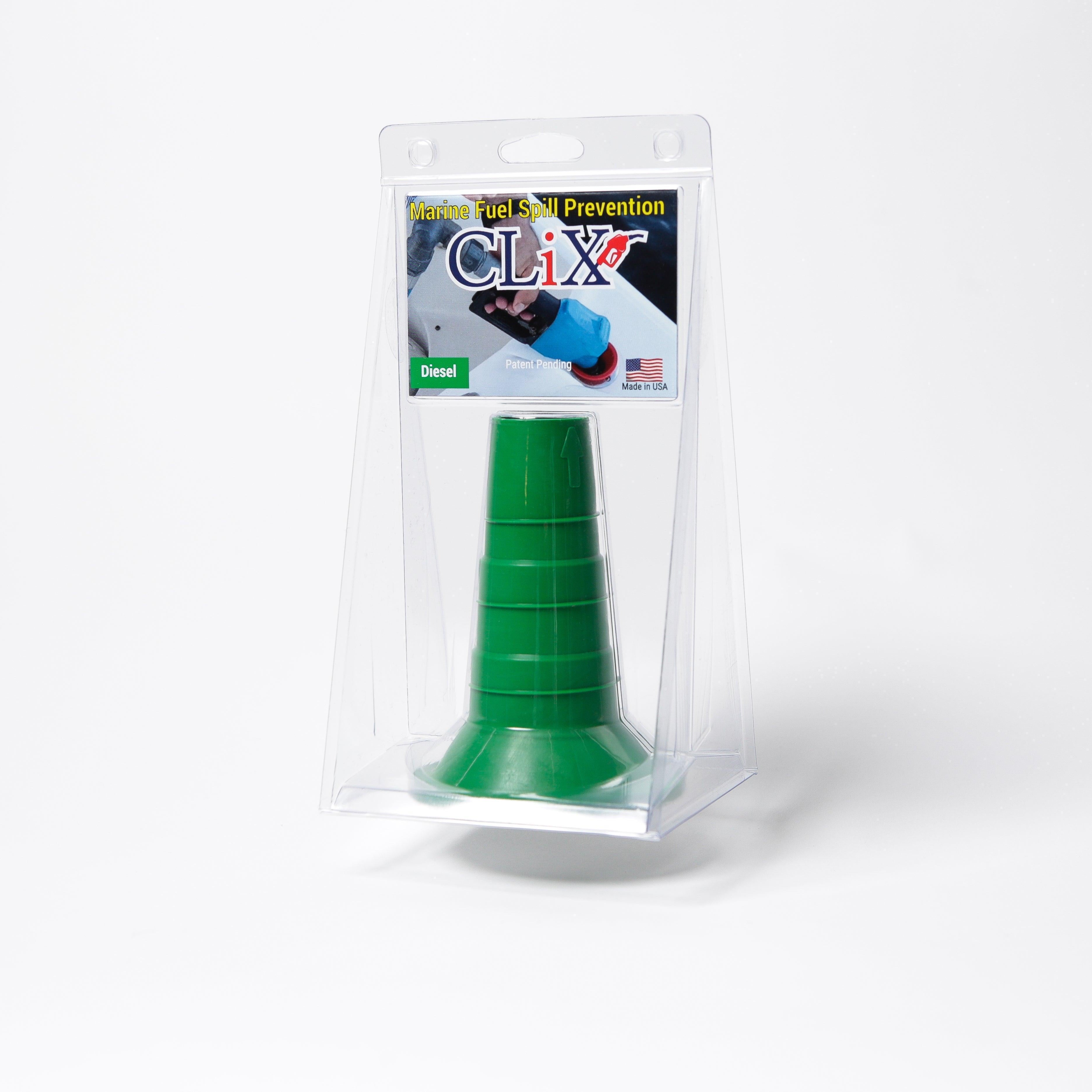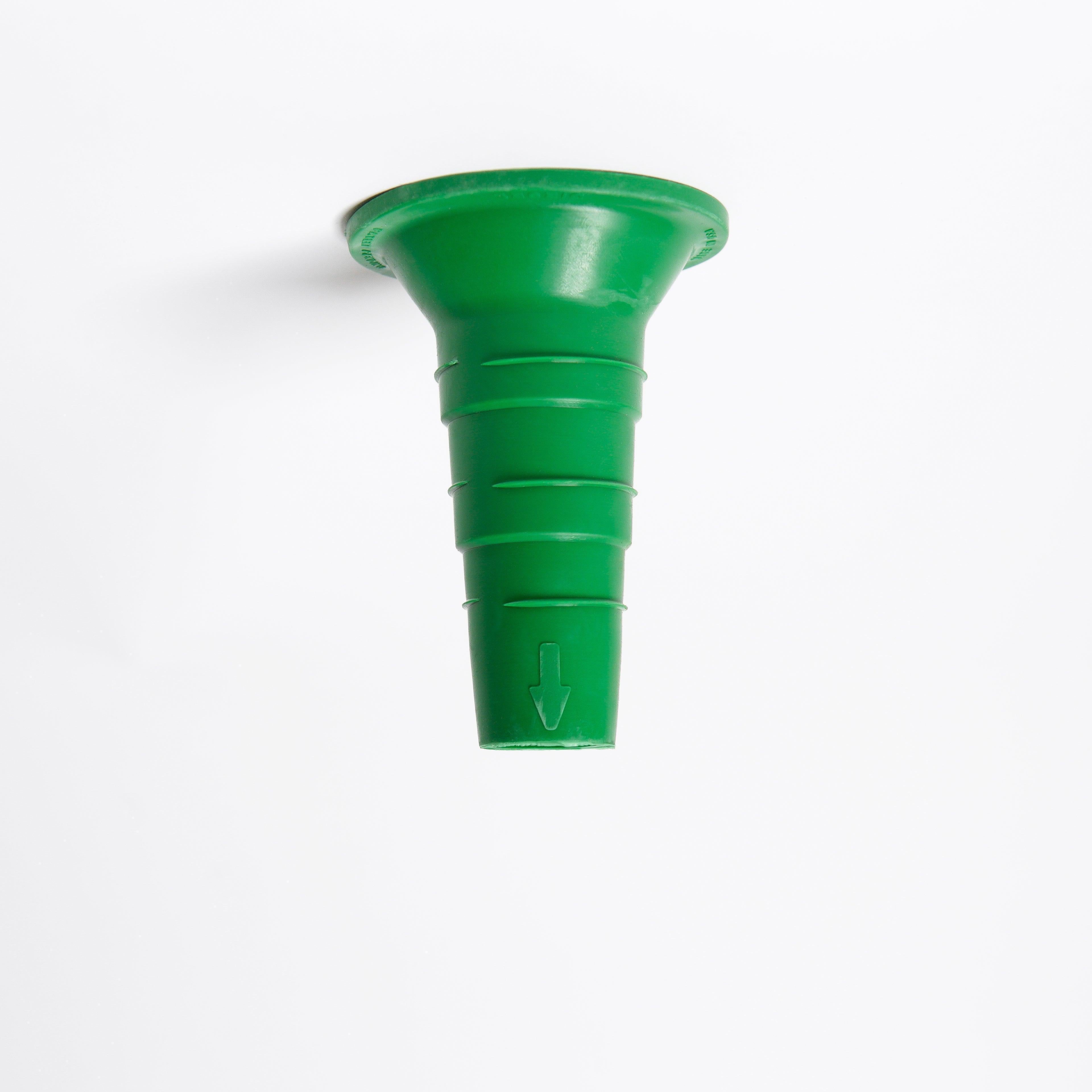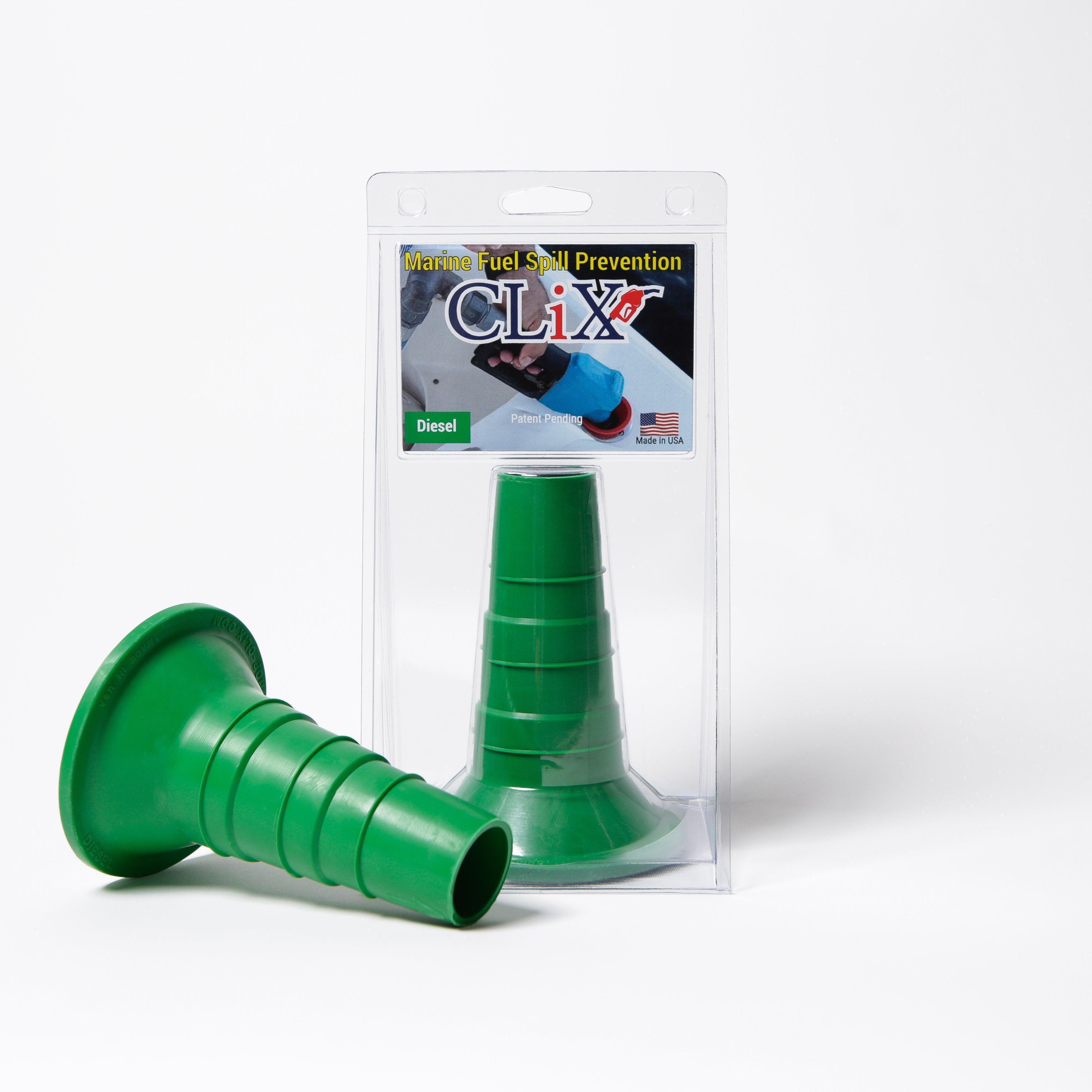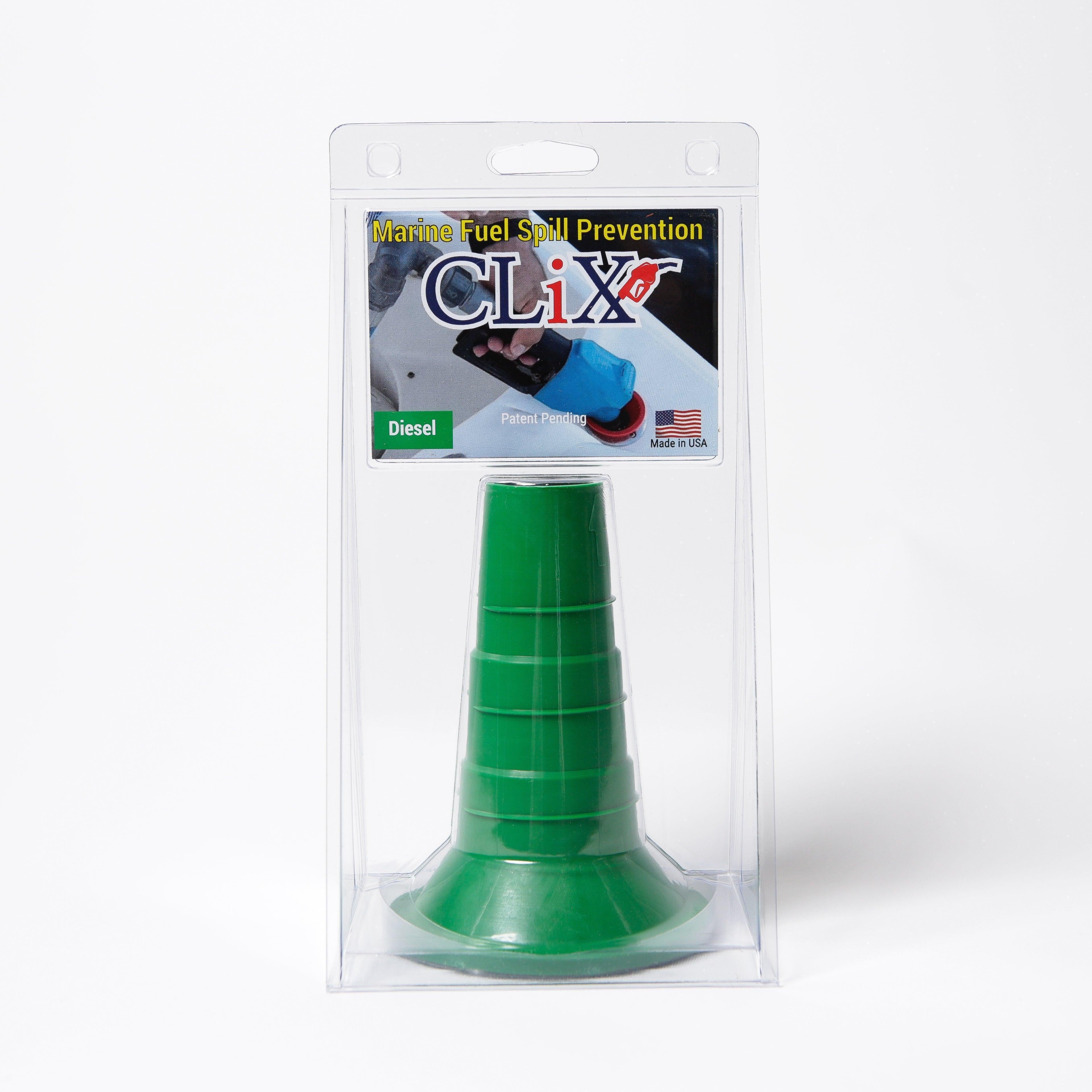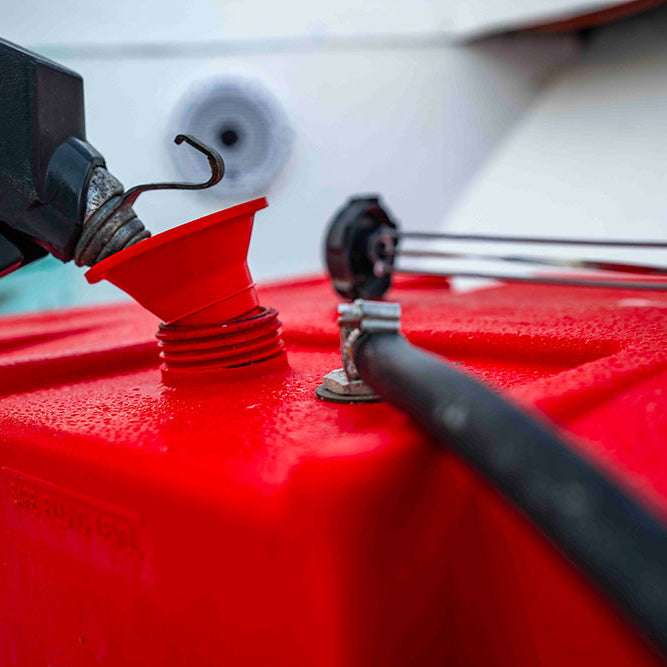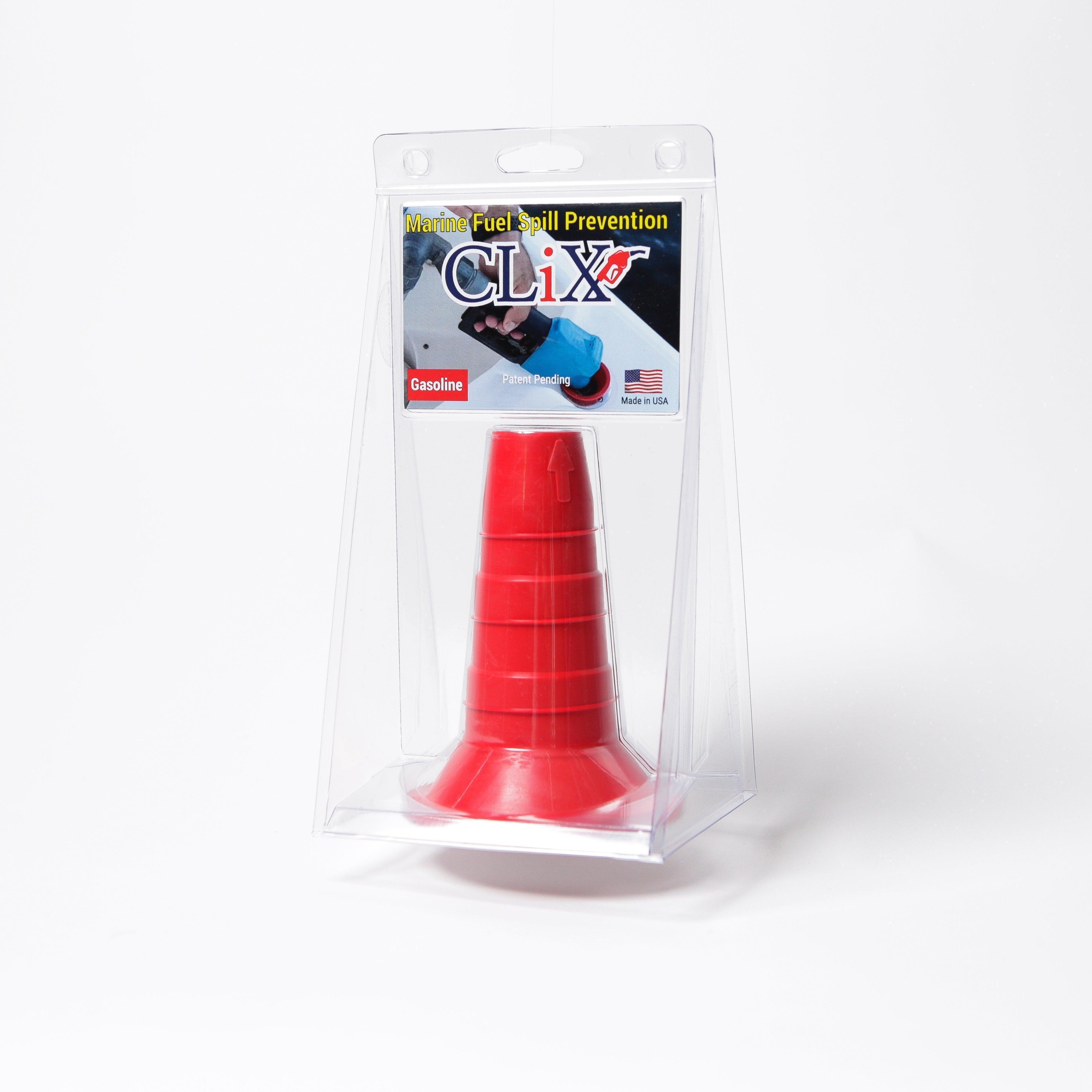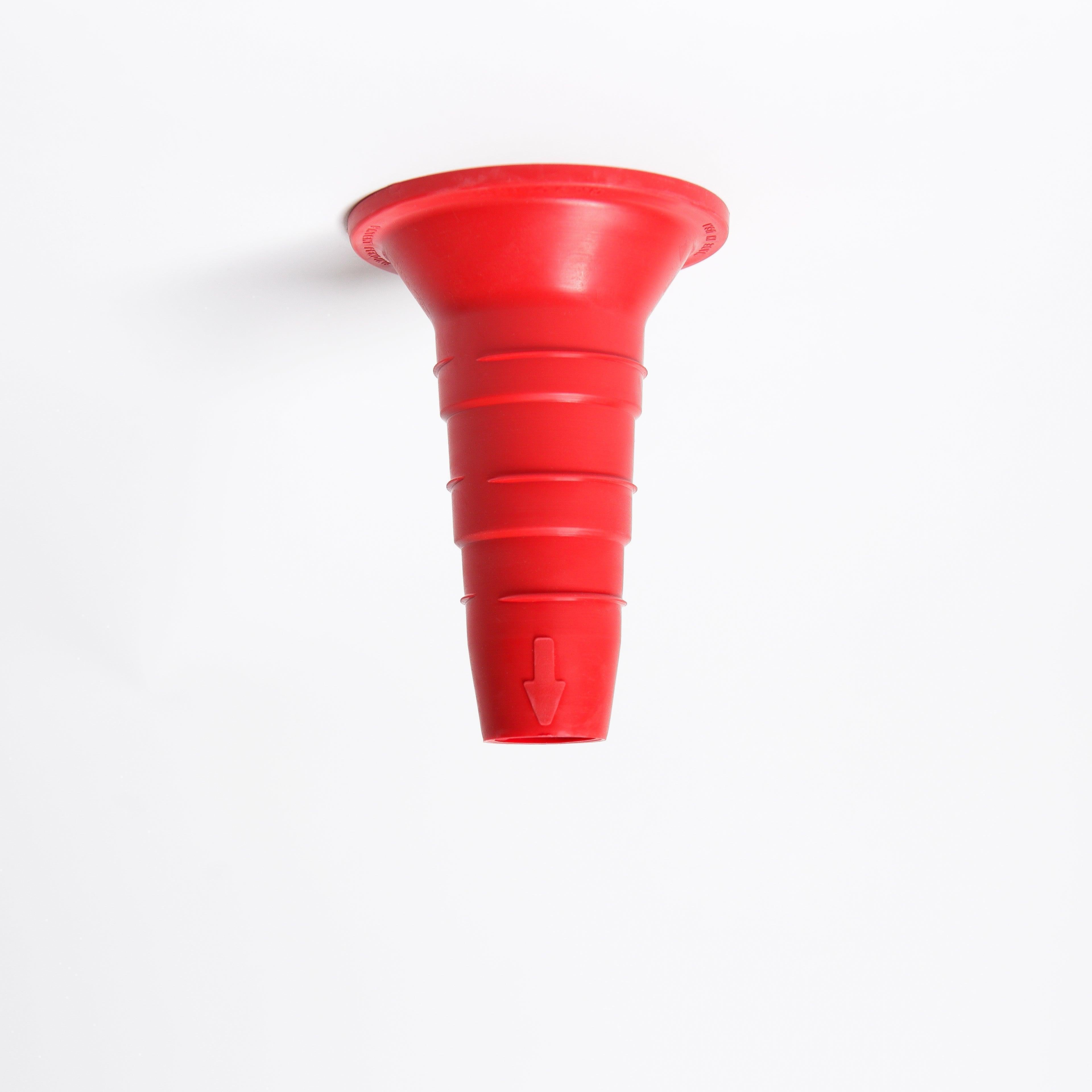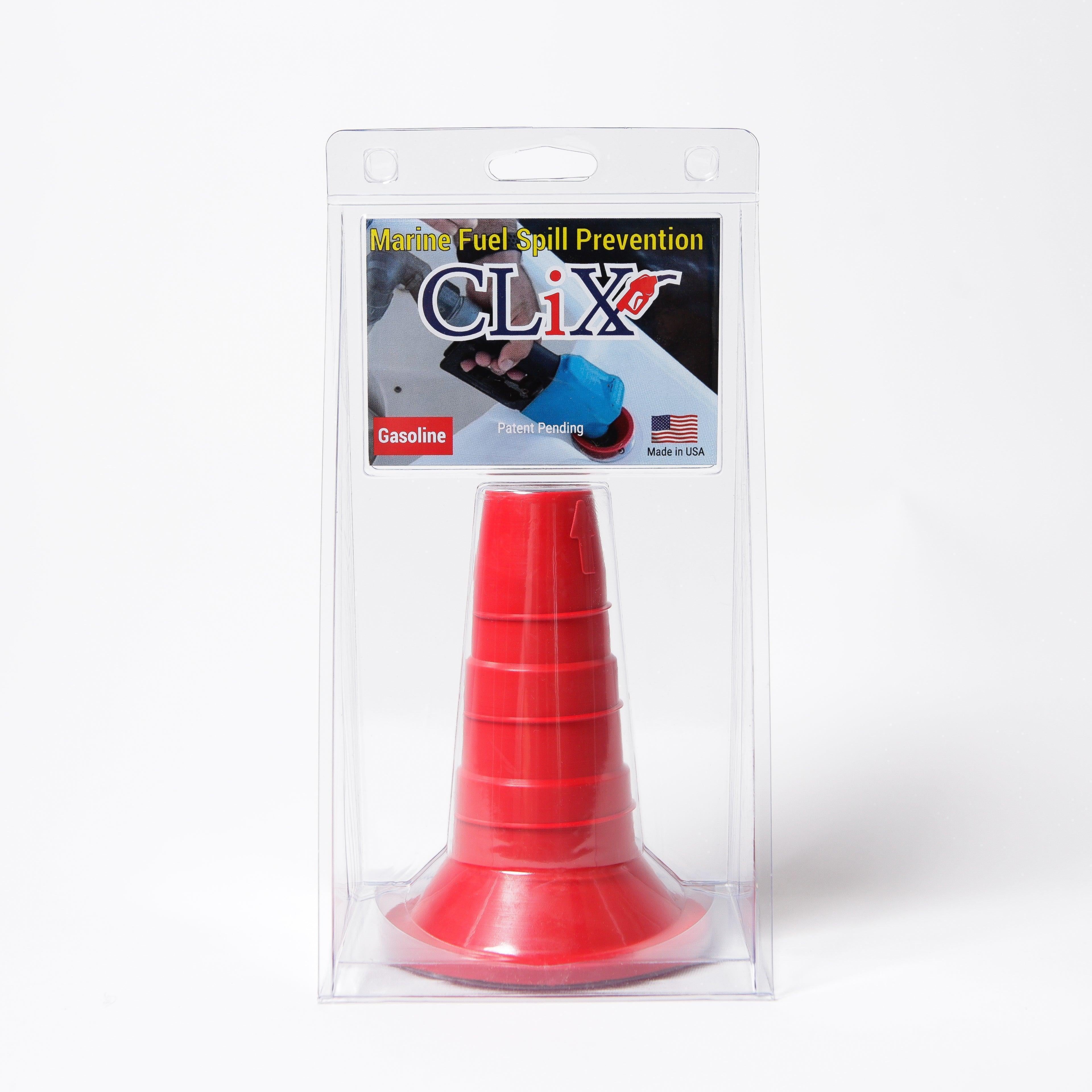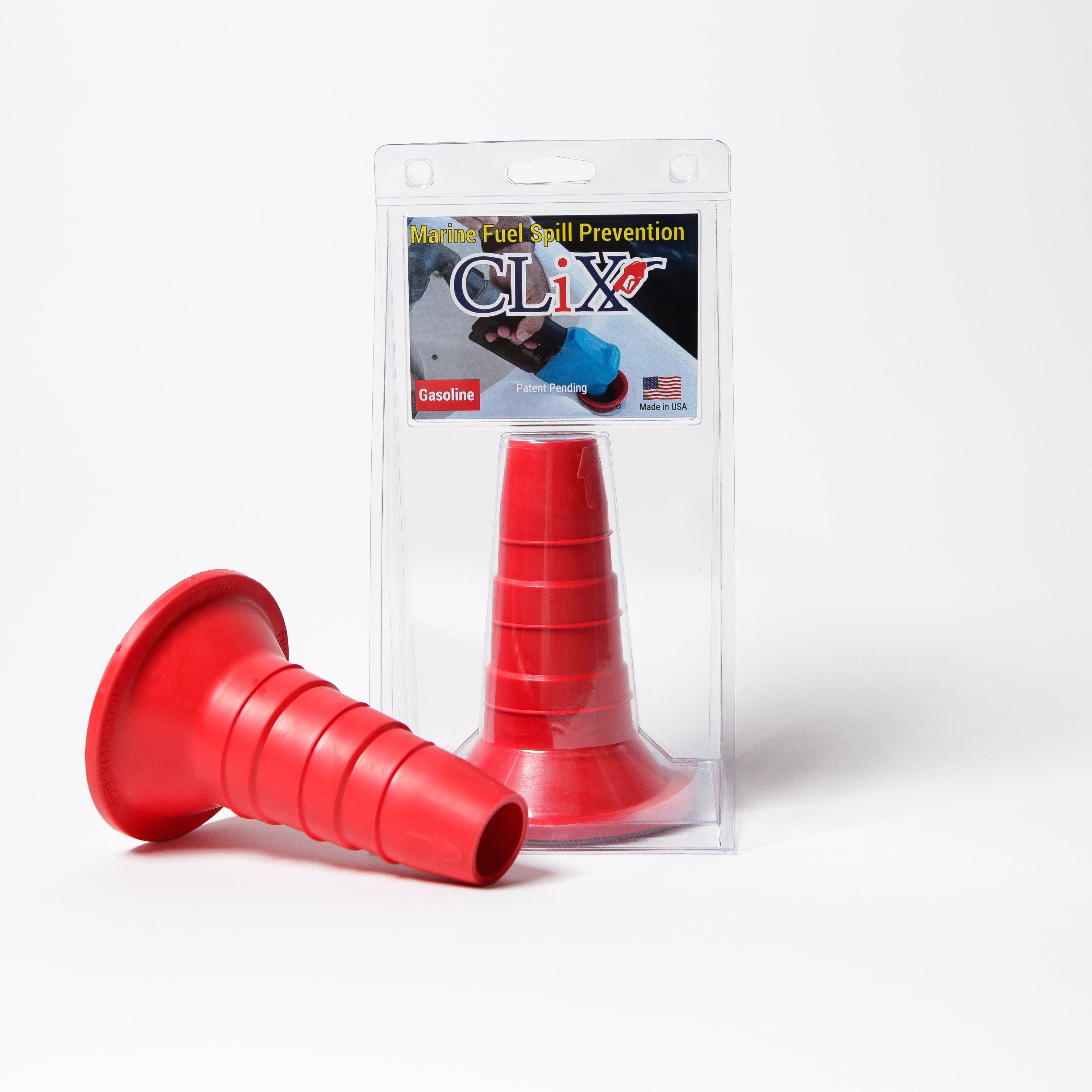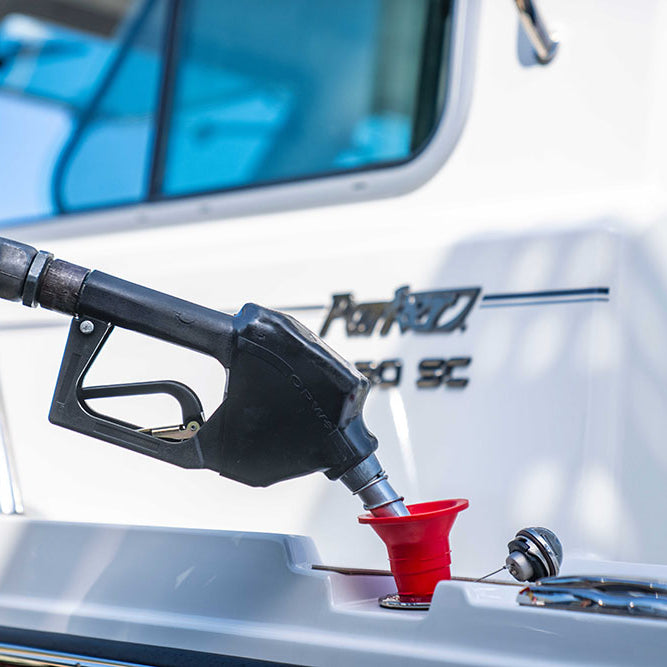A boat fuel tank is much more than just a simple box to hold gasoline or diesel. It’s the core of your boat’s entire fuel system, an engineered piece of equipment built to handle the tough marine environment and keep you safe and running reliably out on the water.
Your Boat's Fuel System Explained
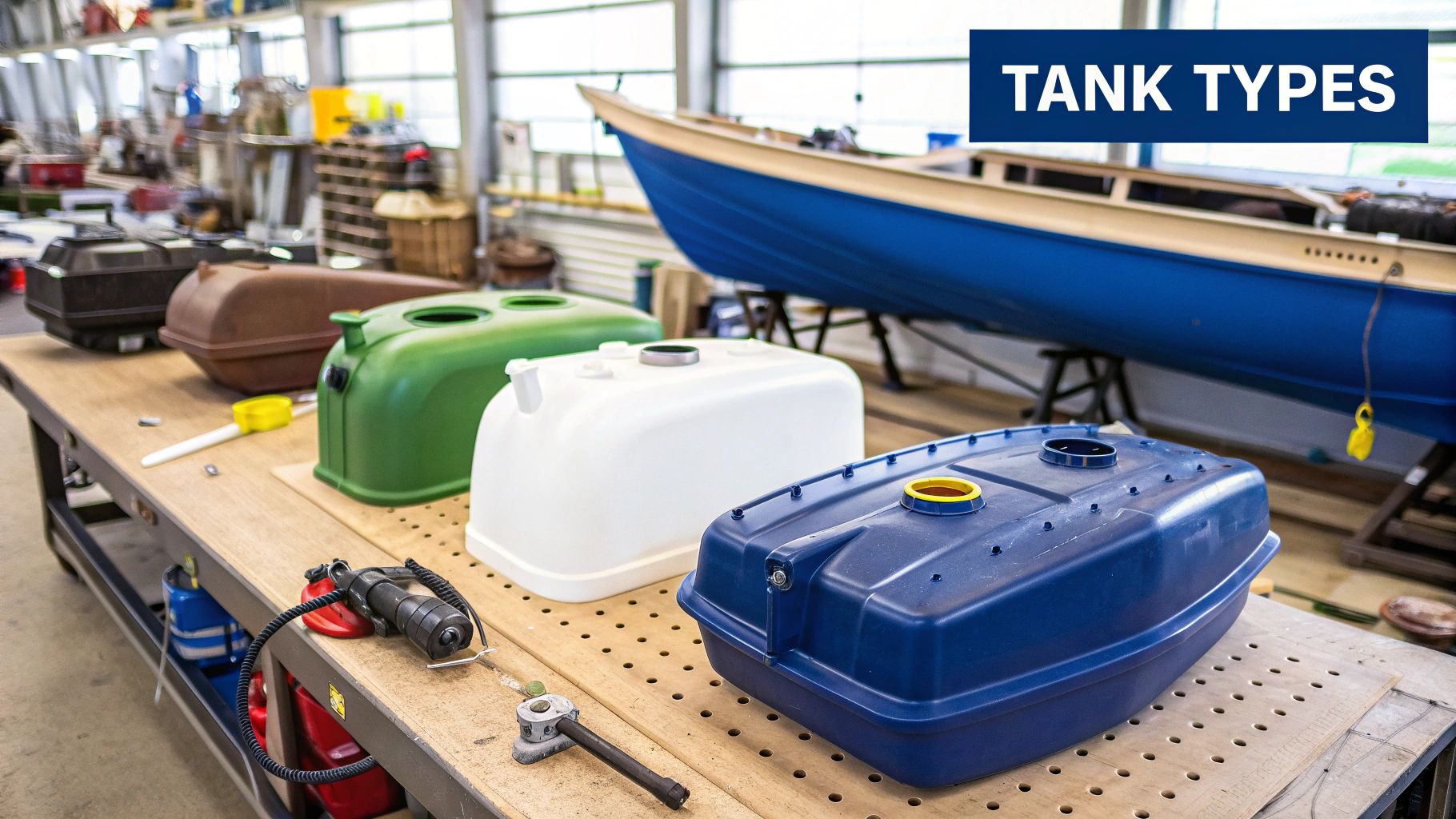
It helps to think of a boat's fuel system like your own body's circulatory system. The fuel tank is the heart, pumping essential fuel through a network of lines—the veins and arteries—that feed the engine. For everything to work right, every single part has to do its job perfectly.
A car’s fuel system has it pretty easy, living in a stable and predictable environment. A boat’s system, on the other hand, is in a constant battle. It has to endure non-stop vibration, high humidity, and the corrosive bite of saltwater. This is exactly why specialized boat fuel tanks aren't just a good idea; they're a must-have for any boater.
The Core Components and Their Roles
A marine fuel system is really a team of crucial parts working together. When you know what each one does, you start to see why skimping on quality is never a good idea.
Here's a quick look at the main players in your boat's fuel system and the roles they play.
| Key Components of a Marine Fuel System | |
|---|---|
| Component | Primary Function |
| The Fuel Tank | The main reservoir, built from tough materials like aluminum or specially-formulated polyethylene plastic. |
| Fuel Lines | The hoses that carry fuel from the tank to the engine, designed to resist fuel and harsh conditions. |
| Fuel Fill & Vent | The fill port is where you add fuel. The vent is a vital safety piece that lets air out during fueling and in as fuel is used, preventing dangerous pressure buildup. |
| Fuel Gauge & Sender | The sender unit inside the tank "reads" the fuel level and sends that information to the gauge on your dash so you know when it's time to head back. |
Each of these parts depends on the others to keep your engine running and, more importantly, to keep you safe.
A boat's fuel system is only as strong as its weakest link. A failure in any one of these components—from a cracked vent line to a corroded tank fitting—can lead to dangerous fuel leaks or engine failure far from shore.
The need for dependable fuel storage is huge and growing. The global market for all fuel storage tanks, which includes marine applications, is expected to climb from USD 16.02 billion in 2025 to over USD 24.22 billion by 2035. You can explore more data on this growth at Future Market Insights.
This growth shows just how much focus is being placed on safe and reliable fuel containment. From the specific materials used to the way it’s mounted in the hull, every detail of a boat fuel tank is designed for the unique challenges of the sea.
Choosing the Right Material for Your Fuel Tank
Picking the right material for your boat's fuel tank is one of those foundational decisions that ripple out to affect everything else—performance, safety, and how much time you'll spend on maintenance down the road. It’s a lot like choosing tires for a car; what works for a daily commuter would be a disaster on an off-road rig. In the marine world, the big three are aluminum, stainless steel, and high-density polyethylene (plastic).
Each material really has its own personality, and each is a better fit for different kinds of boating. The best choice for you will come down to your boat, how you use it, your budget, and even the kind of fuel you're putting in it.
Aluminum: The Custom Classic
For a long time, aluminum was the king of boat fuel tanks, and it's still the go-to for custom builds and classic restorations. Its biggest strength is how easy it is to shape. A skilled fabricator can weld an aluminum tank into almost any form imaginable, which is perfect for tucking it into the unique nooks and crannies of a boat’s hull.
This is exactly why you'll see aluminum in restored classic speedboats or high-performance vessels. It allows builders to squeeze out every last gallon of fuel capacity in tight or weirdly-shaped spaces where a standard off-the-shelf tank just wouldn’t work.
But aluminum has its kryptonite: corrosion. It’s particularly vulnerable to pitting, especially when it’s sitting in bilge water or if moisture gets trapped under its mounting straps. This means you have to be diligent with inspections to catch any potential leaks before they turn into major headaches.
Polyethylene: The Modern Workhorse
High-density polyethylene (HDPE), or what most of us just call plastic, has taken the boating world by storm, and for good reason. Today’s plastic boat fuel tanks are made using a process called rotational molding, which creates a totally seamless, one-piece container. No welds or seams means far fewer places where a leak could start.
The real game-changer with a quality polyethylene tank is its absolute immunity to corrosion. A plastic tank can sit in bilge water for years and not break down, making it a fantastic choice for saltwater anglers or anyone who boats in harsh conditions.
Polyethylene tanks are also incredibly tough and can take a serious knock without denting or cracking. While they usually come in standard sizes, which limits custom-fit options, their sheer reliability and lower price tag have made them the default for most modern boat builders. In fact, just one leading manufacturer cranks out over 1,500 roto-molded tanks every single day, supplying a massive chunk of the industry.
Stainless Steel: The Premium Option
Stainless steel represents the top-shelf choice. It gives you the custom-fabrication possibilities of aluminum but with way better resistance to corrosion. It's a tough, long-lasting material that stands up incredibly well to the abuse of a marine environment.
So what's the catch? It's all about cost and weight. Stainless steel is heavier and more expensive than both aluminum and plastic. That can be a dealbreaker for smaller boats or for anyone working with a tight budget. You'll most often find it in high-end yachts or commercial vessels where the budget is bigger and long-term durability is the absolute top priority.
Comparison of Boat Fuel Tank Materials
To make the decision a bit easier, it helps to see the pros and cons side-by-side. Each material shines in different situations.
| Material | Pros | Cons | Best For |
|---|---|---|---|
| Aluminum | • Highly customizable shapes and sizes • Lightweight • Relatively affordable |
• Susceptible to pitting corrosion • Welds can be failure points • Requires careful installation and inspection |
• Custom builds • Classic boat restorations • Maximizing fuel in odd-shaped spaces |
| Polyethylene (Plastic) | • Completely corrosion-proof • Seamless and leak-resistant • Very durable and impact-resistant • Most affordable option |
• Limited to standard shapes/sizes • Can expand/contract with temperature |
• Most recreational boats • Saltwater environments • Budget-conscious boaters |
| Stainless Steel | • Excellent corrosion resistance • Extremely strong and durable • Can be custom fabricated |
• Heaviest material • Most expensive option • Fabrication requires specialized skill |
• High-end yachts • Commercial vessels • When long-term durability is the #1 priority |
Ultimately, the best tank is the one that best fits your specific needs on the water.
This chart gives you a quick look at the general trade-offs between installing a tank yourself versus hiring a pro.
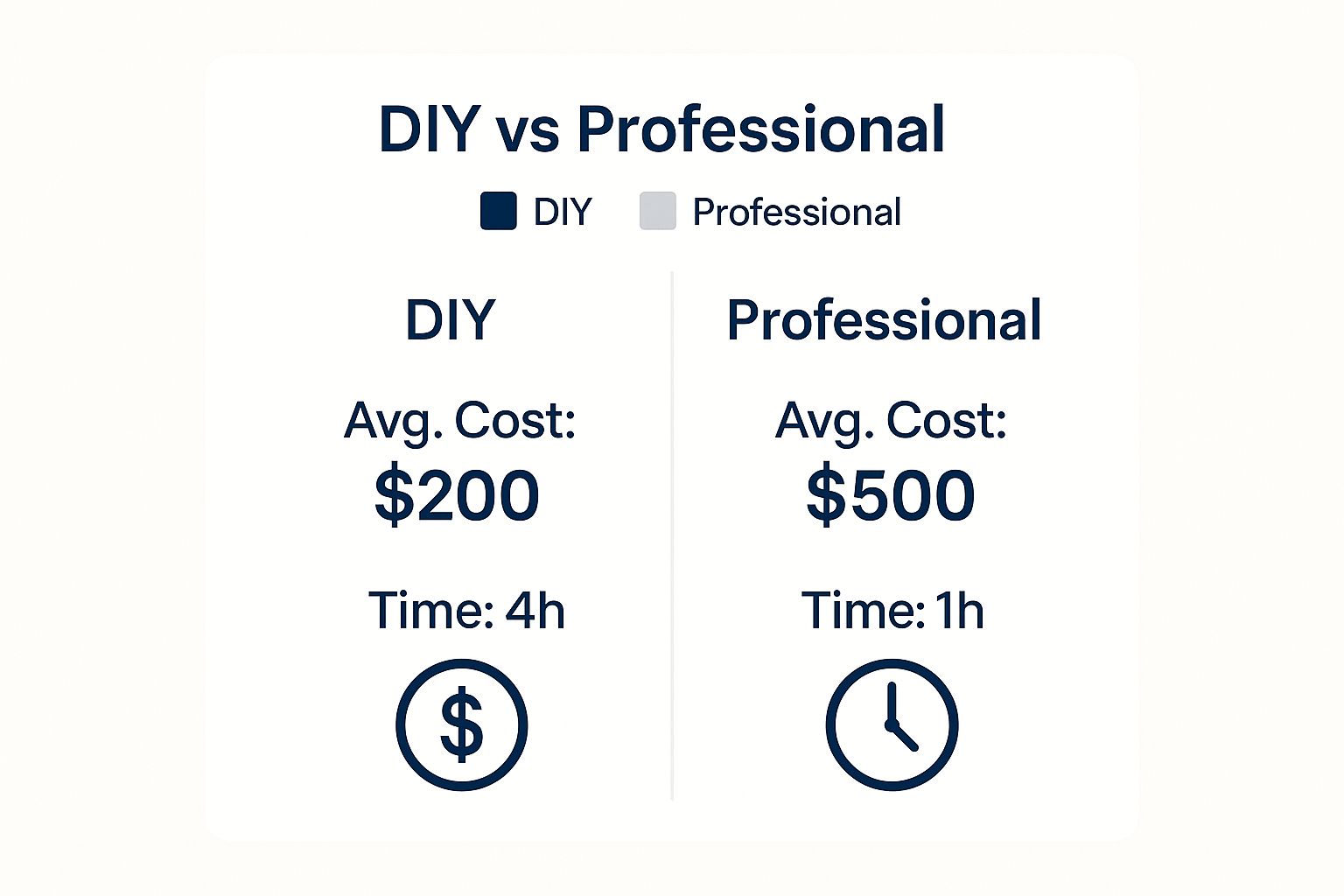
As you can see, going with a professional costs more upfront but can save you a ton of time—a trade-off many boaters are happy to make.
Choosing the right material really boils down to matching its strengths to your boating life. A coastal fisherman who’s always dealing with saltwater spray will love the bulletproof, corrosion-free nature of polyethylene. On the other hand, someone restoring a vintage wooden boat might need a custom-shaped aluminum tank to maintain the boat's original design and balance. If you understand these key differences, you can pick a boat fuel tank that will serve you well for many seasons to come.
How To Correctly Size Your Boat Fuel Tank
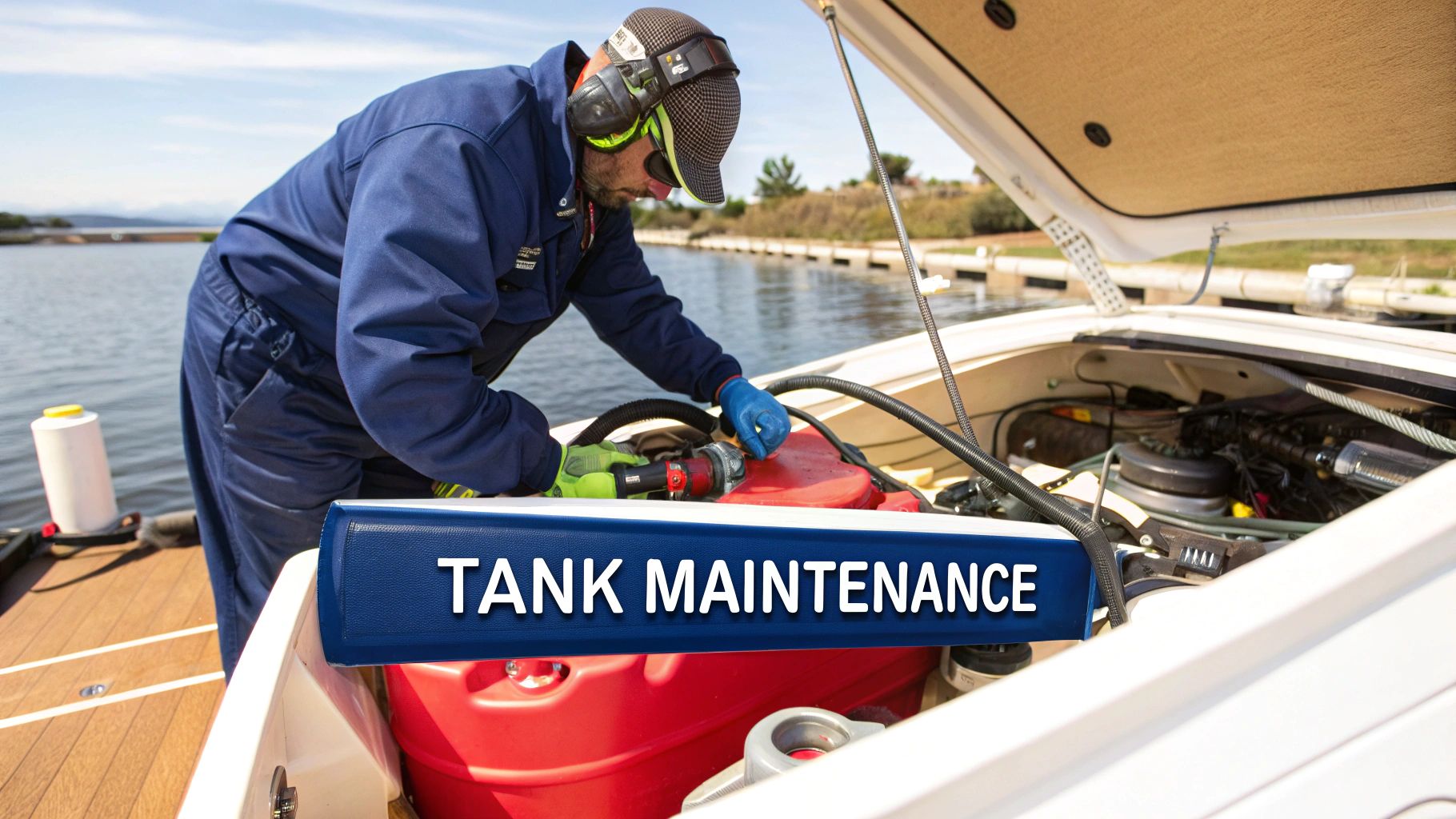
Figuring out the right size for your boat fuel tank can feel like a shot in the dark, but it’s one of the most important decisions you'll make. It directly impacts your range and, more importantly, your safety on the water. Get it wrong, and you’re either lugging around extra weight that hurts performance or, much worse, you're dead in the water miles from shore.
The good news is you don't have to guess. There’s a time-tested principle every seasoned boater lives by.
At the core of all this is the “rule of thirds.” This isn't just some casual tip; it’s a foundational safety rule for any trip you take. It’s a simple, easy-to-remember framework that ensures you always have more than enough fuel to get home safely.
The rule of thirds is simple: plan on using one-third of your fuel to get to your destination, one-third to get back, and keep the final one-third in reserve for the unexpected.
That last third is your lifeline. It's the fuel you need when things don't go according to plan—a sudden storm, fighting a strong current, helping another boater, or having to take the long way back. Following this rule means you're never running on fumes.
Calculating Your Ideal Tank Size
With the rule of thirds as our guide, we can pin down the perfect tank size with some simple math. This takes your boating habits and turns them into a concrete number of gallons, completely removing the guesswork.
First, you'll need to know three things:
- Engine Fuel Consumption: How many gallons per hour (GPH) does your engine burn at cruising speed? You can usually find this in the owner's manual or by looking up the specs.
- Average Trip Distance: How far is the longest round trip you typically make?
- Cruising Speed: What’s your comfortable cruising speed in miles per hour (MPH)?
Got those numbers? The rest is easy.
Putting the Formula into Practice
Let's walk through a real-world example. Say your boat’s engine burns 10 gallons per hour (GPH) while cruising at 30 miles per hour (MPH). Your go-to fishing spot is 45 miles away, making for a 90-mile round trip.
-
First, find your total trip time:
- Trip Distance (90 miles) / Cruising Speed (30 MPH) = 3 hours
-
Next, calculate the fuel needed for the trip:
- Trip Time (3 hours) x Fuel Consumption (10 GPH) = 30 gallons
That 30 gallons covers your journey out and back. It represents the first two-thirds of your tank.
-
Now, add the one-third reserve:
- Your reserve is simply half of your trip fuel: 30 gallons / 2 = 15 gallons.
-
Finally, determine your ideal tank size:
- Trip Fuel (30 gallons) + Reserve Fuel (15 gallons) = 45 gallons.
Based on this, a 45-gallon tank is your minimum safe size. Of course, many boaters will round up to a 50 or 60-gallon tank just for an extra peace of mind. To learn more, check out our guide on how to maximize your range with the right boat fuel tank capacity.
This straightforward approach makes sure your boat fuel tank gives you a safe, practical range without weighing your boat down unnecessarily.
Essential Installation and Safety Regulations
When you're dealing with fuel on a boat, you don't get second chances. A properly installed boat fuel tank isn't just a part of the boat—it's arguably the most critical safety system you have. Getting it wrong can lead to catastrophic failure, from slow fuel leaks and dangerous fume buildup to the very real risk of fire or explosion. That’s why there are strict, non-negotiable standards in place to protect you, your passengers, and your vessel.
Whether you're a DIYer taking on a refit or you're hiring a marine pro, understanding these core principles is essential. The American Boat and Yacht Council (ABYC) sets the gold standard for marine safety, and their fuel system guidelines are the bedrock of safe boating. It helps to think of these rules less as a hassle and more as a proven blueprint for keeping everyone safe on the water.
Proper Tank Placement and Stability
Think about where you're putting that tank. A full tank is incredibly heavy—gasoline is about 6 pounds per gallon, and diesel is over 7. A poorly positioned tank can completely throw off your boat’s center of gravity, making it feel tippy, handle unpredictably, and become downright dangerous in rough seas.
The sweet spot is as low and as close to the boat's centerline as you can get it. This placement minimizes the tank's impact on the boat's balance and makes for a much smoother, more stable ride. Just as important, the tank must be completely isolated from any potential source of ignition. That means keeping it well clear of engines, batteries, and any electrical wiring that could create a stray spark.
A critical, non-negotiable part of the install is making sure that tank can't move. Period. The ABYC standards are crystal clear on this: the tank has to be strapped or bracketed down so it can't shift forward, backward, sideways, or up and down. A heavy tank sliding around in rough water can be just as dangerous as poor initial placement.
Ventilation: The Unseen Safety Net
One of the most vital, yet most often overlooked, parts of any fuel system is its ventilation. It's easy to forget about, but it's constantly working. As your engine sips fuel, air has to get into the tank to replace it. And when the tank heats up in the sun, fuel vapors have to get out. Without a clear vent, you can create a vacuum that starves your engine or, worse, build up dangerous pressure inside the tank.
A proper vent system is pretty straightforward but has a few key features:
- External Vent Fitting: The vent line must run to a fitting on the outside of the hull, placed where it won’t easily take on water but allows fumes to dissipate safely away from the cockpit and cabin.
- Clear and Unobstructed Lines: The vent hose can't have any low spots or "sags" where fuel or condensation can pool and create a blockage. A blocked vent is a serious hazard waiting to happen.
- Flame Arrestor: That little screen inside the vent fitting is a flame arrestor. It's there to stop an external fire from flashing back down the vent line and into your tank.
This entire system is your boat's way of breathing, making sure explosive fumes never get a chance to build up inside your hull. For a deeper dive into this, you can find a comprehensive boat fuel tank guide with tips for safety and maintenance that goes into even more detail.
The Importance of Anti-Siphon Protection
Here’s a scary thought: imagine a fuel line below the level of the tank gets a small leak. Physics takes over, and a siphon effect could start, silently draining your entire tank of fuel directly into the bilge. This isn't just an environmental nightmare; it turns your boat into a floating bomb.
This is exactly why regulations require an anti-siphon valve (or another form of protection) on all gasoline fuel systems where any part of the fuel line drops below the tank's top. It's a simple, spring-loaded valve installed right where the fuel line leaves the tank.
The valve stays shut until the engine's fuel pump creates enough suction to pull it open. The moment the engine stops or a line breaks, that suction is gone, and the valve snaps closed, instantly stopping the fuel flow. It's a tiny, inexpensive part that provides a massive amount of protection. Following these standards isn't just about compliance—it’s the only way to get true peace of mind when you head out on the water.
Modern Fuel Gauges and Monitoring Systems
https://www.youtube.com/embed/PNF8FcTfT1A
Knowing exactly how much fuel is left in your boat fuel tanks is more than just a nice-to-have—it's a critical piece of your safety puzzle. An old-school, bouncy needle gauge might give you a rough idea, but modern systems provide the kind of accuracy that can completely change how you approach a day on the water.
The era of squinting at an analog gauge and just hoping for the best is thankfully coming to an end. More and more boaters are upgrading to digital monitoring systems that deliver reliable, real-time data. This isn't just about getting a cool new gadget; it’s about making smarter, safer decisions.
From Floats to Digital Precision
The traditional fuel gauge is a pretty simple mechanical device. Inside the tank, a float arm bobs up and down with the fuel level—think of the float in your toilet's tank. This arm moves a resistor, which sends a changing electrical signal to the gauge on your dash. It's a system that gets the job done, but its accuracy is easily compromised by the constant sloshing of fuel when the boat is moving.
Modern systems use much more sophisticated technology that isn't so easily fooled by a little chop. They give you a steady, trustworthy reading you can count on.
Some of the most common technologies include:
- Ultrasonic Senders: These are mounted on top of the tank and shoot sound waves down to the fuel's surface. They calculate the fuel level by measuring how long it takes for the echo to bounce back. The best part? Sloshing fuel has zero effect on their precision.
- Capacitance Senders: These are fixed tubes with no moving parts at all. They work by measuring the difference in electrical capacitance between the fuel and the air inside the tube. This makes them incredibly stable and durable.
This push for better accuracy is part of a huge and growing market. In 2025, the global market for fuel tank indicators is valued at around USD 2.82 billion, with North America leading the way. You can see the full market projections, which forecast this segment to hit nearly USD 1.66 billion in North America by 2033, over at Cognitive Market Research.
The Real-World Benefits of Accurate Monitoring
Upgrading your fuel gauge is about more than just a fancier dashboard. It brings real, practical benefits that affect both your safety and your wallet. When you can truly trust your fuel reading, you can start fine-tuning every trip.
You can finally dial in your engine's performance, discovering the most efficient cruising speed to get the most out of every gallon. This kind of precision means you burn less fuel, save money, and get to spend more time enjoying the water.
But the biggest advantage might just be saying goodbye to "range anxiety." Knowing your exact fuel level gives you the confidence to explore a little further, secure in the knowledge that you have plenty of fuel to get back to the dock without a problem.
Choosing the right system can feel like a big decision, but understanding the technology is the first step. If you're looking to upgrade, our guide to the top marine fuel gauges for accurate boat monitoring is a great resource for comparing options and finding the right fit for your boat.
At the end of the day, a modern monitoring system and a dependable boat fuel tank are the bedrock of safety and efficiency. They give you the power to manage your fuel with near-perfect precision, helping you avoid the dangerous and expensive mistake of running dry far from shore.
What's Next for Marine Fuel and Tank Tech?
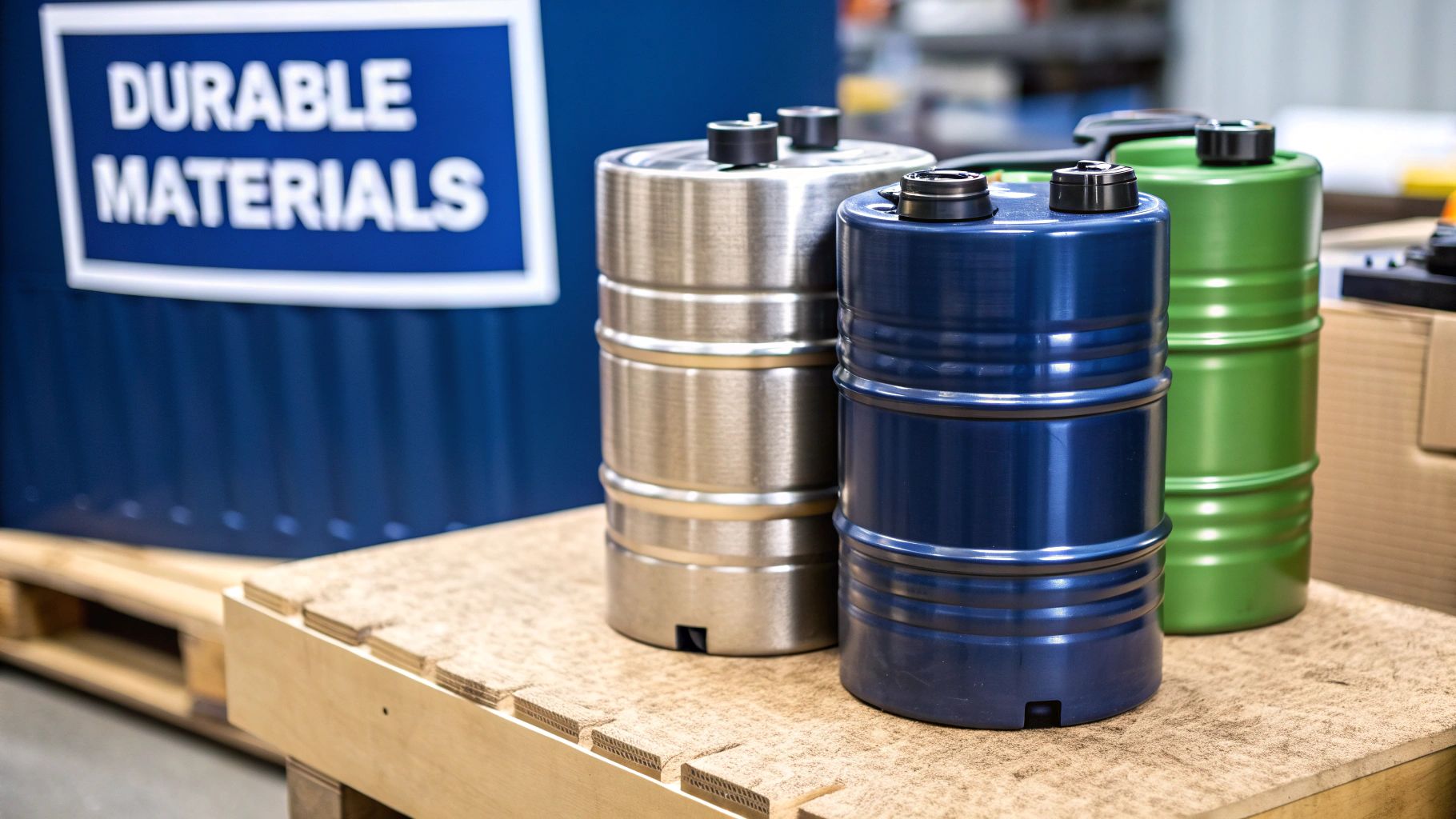
The technology behind boat fuel tanks is anything but stagnant. As the entire marine industry charts a course toward better efficiency and environmental stewardship, the fuel tank is evolving right along with it. The biggest catalyst for this change is the powerful push for cleaner, alternative fuels.
You can see this shift most clearly in the global shipping sector, where tough new environmental rules are forcing a move away from old-school bunker fuel. The alternative that's really gaining steam is Liquefied Natural Gas (LNG). This is having a ripple effect across the industry, forcing engineers to completely rethink how fuel is stored on a vessel.
This drive for cleaner energy is firing up a huge new market. The marine LNG fuel tank industry alone is forecast to hit around USD 2.5 billion by 2025 and is projected to grow at a healthy clip of about 8% CAGR through 2033. These numbers show just how seriously the industry is investing in a greener future. You can dig deeper into these marine LNG tank market trends to grasp the full scale of this transformation.
The Challenge of Cryogenic Storage
Here's the thing about LNG: you can't just pump it into a standard tank. It has to be kept at a mind-bogglingly cold -260°F (-162°C) to stay in its liquid form. This demands a totally different kind of boat fuel tank—a cryogenic one.
Think of it as a massive, highly engineered thermos bottle. These tanks have multiple layers, with a vacuum-sealed space sandwiched between an inner and outer wall. This vacuum insulation is incredibly good at keeping heat out so the fuel stays cold.
The materials have to be special, too. They need to handle the extreme cold without getting brittle and cracking under pressure. It’s a serious engineering puzzle, but brilliant new designs are making LNG a practical option for more and more vessels.
Smarter and Safer Fueling
While new fuels are shaping the long-term future, there’s plenty of innovation happening right now at the fuel dock. For years, the simple act of filling up has been a source of headaches and environmental risk. Overfill your tank, and you can ruin your boat's finish and—much worse—spill toxic fuel into the water.
Fuel spills aren't just a messy inconvenience; they are a preventable environmental problem. A single gallon of spilled fuel can contaminate up to one million gallons of water, devastating marine life and fragile ecosystems.
This is where smart fueling technology steps in. A system like the one from CLiX Fueling Solutions is designed to make overfills a thing of the past. It creates an automatic shut-off that works with any standard fuel nozzle, making the whole process spill-proof and worry-free.
This type of focused, practical improvement delivers real benefits right away:
- Environmental Protection: It physically stops fuel from polluting our waterways.
- Boat Protection: It prevents corrosive fuel from eating away at gelcoat, paint, and decals.
- Peace of Mind: You can fuel up with total confidence, knowing the pump will click off at just the right time.
The future of boat fuel tanks and fueling systems is really a two-part story. On one side, you have these massive engineering leaps to handle next-generation fuels like LNG. On the other, you have smart, simple solutions that make boating today safer and cleaner for everyone.
Answering Your Top Questions About Boat Fuel Tanks
Even when you know the basics about materials and regulations, the real world of boating always throws a few curveballs. Over the years, I've heard the same questions pop up time and time again from fellow boaters.
Let's walk through some of the most common puzzles you'll face with your boat fuel tanks and get you some clear, practical answers.
How Often Should I Really Be Checking My Fuel Tank?
Think of regular inspections as your best defense against a ruined day on the water. A quick look-over should happen at least once a month, with a more serious, in-depth check scheduled once a year.
Your monthly once-over is simple. Just keep an eye out for the obvious red flags:
- Corrosion: Look at any metal parts you can see, paying close attention to fittings and the straps holding the tank in place.
- Cracks or Damage: For plastic tanks, scan for any stress marks or visible damage.
- Leaks: Use your nose and your eyes. Check all fuel line connections for any sign of dampness or that distinct smell of fuel.
For your annual inspection, you need to dig a little deeper. If you can, check under the tank and its straps—that's a classic spot for moisture to hide and start causing trouble. If you think you might have sludge or contamination inside the tank, don't try to be a hero. It's time to call in a certified marine mechanic. They have the right tools to safely see what's going on in there.
What Are the Telltale Signs of Water in My Fuel?
Water in your fuel is a boater's oldest enemy, and it can wreak havoc on your engine. The classic symptoms are an engine that sputters, refuses to start, or dies on you right when you're cruising. That's a big clue that your engine is trying to run on water instead of fuel.
Because water is heavier than fuel, it sinks to the very bottom of your tank. Your first and best line of defense is a quality fuel/water separating filter. Its entire job is to catch that water before it ever gets near your engine. Make checking and draining this filter a non-negotiable part of your regular maintenance.
If you drain your filter and find more than just a little bit of water, that's a major warning sign. It means you've got a bigger issue, and you'll likely need a pro to pump the entire tank dry to avoid catastrophic engine damage.
Can I Actually Get a Leaking Fuel Tank Repaired?
Let's be blunt: repairing a leaking fuel tank is not a DIY job. It’s an incredibly high-stakes task that belongs in the hands of seasoned professionals. The risk of an explosion from leftover fuel vapors is just too high to mess around with.
While it's technically possible to repair a tank—using specialized welding for aluminum or plastic—it’s a complicated and expensive process. The tank has to be removed from the boat and professionally steamed and cleaned to get rid of every last trace of explosive fumes before anyone can even think about starting a repair.
Honestly, given the massive safety risks and the chance of a patch failing down the road, replacement is almost always the smarter, safer, and more reliable choice. The peace of mind that comes with a brand-new, solid boat fuel tank is worth every penny compared to the potential disaster of a leaky patch.
Is "Fuel Polishing" Something I Actually Need?
Fuel polishing is just a fancy term for a deep-cleaning service for the fuel that’s already in your tank. The process involves circulating your boat's fuel through a powerful external filtering system that strips out water, gunk, microbial sludge, and any other junk that's accumulated.
So, when should you consider it?
- If your boat sits idle for long stretches of time.
- If you have a gut feeling you got a bad batch of fuel at the pump.
- If you notice your onboard fuel filters are getting clogged way faster than usual.
It’s especially helpful for diesel engines, as they are notoriously sensitive to contaminated fuel. By getting all that gunk out, fuel polishing helps prevent expensive engine headaches and ensures your fuel is ready to perform when you fire up the engine.
Tired of the stress and mess of fueling your boat? CLiX Fueling Solutions offers a simple, effective way to prevent costly overfills and protect the environment. Learn how our automatic shut-off system can give you a spill-free fueling experience every time by visiting our CLiX Fueling Solutions website.


